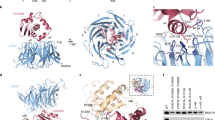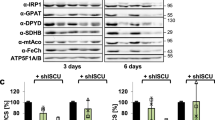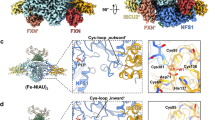Abstract
Cytosolic and nuclear iron-sulfur (Fe-S) proteins play key roles in processes such as ribosome maturation, transcription and DNA repair-replication. For biosynthesis of their Fe-S clusters, a dedicated cytosolic Fe-S protein assembly (CIA) machinery is required. Here, we identify the essential flavoprotein Tah18 as a previously unrecognized CIA component and show by cell biological, biochemical and spectroscopic approaches that the complex of Tah18 and the CIA protein Dre2 is part of an electron transfer chain functioning in an early step of cytosolic Fe-S protein biogenesis. Electrons are transferred from NADPH via the FAD- and FMN-containing Tah18 to the Fe-S clusters of Dre2. This electron transfer chain is required for assembly of target but not scaffold Fe-S proteins, suggesting a need for reduction in the generation of stably inserted Fe-S clusters. The pathway is conserved in eukaryotes, as human Ndor1–Ciapin1 proteins can functionally replace yeast Tah18–Dre2.
This is a preview of subscription content, access via your institution
Access options
Subscribe to this journal
Receive 12 print issues and online access
$259.00 per year
only $21.58 per issue
Buy this article
- Purchase on Springer Link
- Instant access to full article PDF
Prices may be subject to local taxes which are calculated during checkout






Similar content being viewed by others
References
Johnson, D.C., Dean, D.R., Smith, A.D. & Johnson, M.K. Structure, function and formation of biological iron-sulfur clusters. Annu. Rev. Biochem. 74, 247–281 (2005).
Lill, R. & Mühlenhoff, U. Maturation of iron-sulfur proteins in eukaryotes: Mechanisms, connected processes, and diseases. Annu. Rev. Biochem. 77, 669–700 (2008).
Rouault, T.A. & Tong, W.H. Iron-sulfur cluster biogenesis and human disease. Trends Genet. 24, 398–407 (2008).
Lill, R. Function and biogenesis iron-sulphur proteins. Nature 460, 831–838 (2009).
Fontecave, M. & Ollagnier-de-Choudens, S . Iron-sulfur cluster biosynthesis in bacteria: Mechanisms of cluster assembly and transfer. Arch. Biochem. Biophys. 474, 226–237 (2008).
Craig, E.A. & Marszalek, J. A specialized mitochondrial molecular chaperone system: a role in formation of Fe-S centers. Cell. Mol. Life Sci. 59, 1658–1665 (2002).
Mühlenhoff, U., Gerber, J., Richhardt, N. & Lill, R. Components involved in assembly and dislocation of iron-sulfur clusters on the scaffold protein Isu1p. EMBO J. 22, 4815–4825 (2003).
Dutkiewicz, R. et al. The Hsp70 chaperone Ssq1p is dispensable for iron-sulfur cluster formation on the scaffold protein Isu1p. J. Biol. Chem. 281, 7801–7808 (2006).
Biederbick, A. et al. Role of human mitochondrial Nfs1 in cytosolic iron-sulfur protein biogenesis and iron regulation. Mol. Cell. Biol. 26, 5675–5687 (2006).
Mühlenhoff, U. et al. Functional characterization of the eukaryotic cysteine desulfurase Nfs1p from Saccharomyces cerevisiae. J. Biol. Chem. 279, 36906–36915 (2004).
Kispal, G., Csere, P., Prohl, C. & Lill, R. The mitochondrial proteins Atm1p and Nfs1p are required for biogenesis of cytosolic Fe-S proteins. EMBO J. 18, 3981–3989 (1999).
Roy, A., Solodovnikova, N., Nicholson, T., Antholine, W. & Walden, W.E. A novel eukaryotic factor for cytosolic Fe-S cluster assembly. EMBO J. 22, 4826–4835 (2003).
Hausmann, A. et al. The eukaryotic P-loop NTPase Nbp35: An essential component of the cytosolic and nuclear iron-sulfur protein assembly machinery. Proc. Natl. Acad. Sci. USA 102, 3266–3271 (2005).
Netz, D.J., Pierik, A.J., Stümpfig, M., Mühlenhoff, U. & Lill, R. The Cfd1-Nbp35 complex acts as a scaffold for iron-sulfur protein assembly in the yeast cytosol. Nat. Chem. Biol. 3, 278–286 (2007).
Balk, J., Pierik, A.J., Aguilar Netz, D., Mühlenhoff, U. & Lill, R. The hydrogenase-like Nar1p is essential for maturation of cytosolic and nuclear iron-sulphur proteins. EMBO J. 23, 2105–2115 (2004).
Urzica, E., Pierik, A.J., Muhlenhoff, U. & Lill, R. Crucial role of conserved cysteine residues in the assembly of two iron-sulfur clusters on the CIA protein Nar1. Biochemistry 48, 4946–4958 (2009).
Balk, J., Aguilar Netz, D.J., Tepper, K., Pierik, A.J. & Lill, R. The essential WD40 protein Cia1 is involved in a late step of cytosolic and nuclear iron-sulfur protein assembly. Mol. Cell. Biol. 25, 10833–10841 (2005).
Srinivasan, V. et al. Structure of the yeast WD40 domain protein Cia1, a component acting late in iron-sulfur protein biogenesis. Structure 15, 1246–1257 (2007).
Zhang, Y. et al. Dre2, a conserved eukaryotic Fe-S cluster protein, functions in cytosolic Fe-S protein biogenesis. Mol. Cell. Biol. 28, 5569–5582 (2008).
Song, D. & Lee, F.S. A role for IOP1 in mammalian cytosolic iron-sulfur protein biogenesis. J. Biol. Chem. 283, 9231–9238 (2008).
Stehling, O. et al. Human Nbp35 is essential for both cytosolic iron-sulfur protein assembly and iron homeostasis. Mol. Cell. Biol. 28, 5517–5528 (2008).
Chanet, R. & Heude, M. Characterization of mutations that are synthetic lethal with pol3–13, a mutated allele of DNA polymerase delta in Saccharomyces cerevisiae. Curr. Genet. 43, 337–350 (2003).
Yu, H. et al. High-quality binary protein interaction map of the yeast interactome network. Science 322, 104–110 (2008).
Krogan, N.J. et al. Global landscape of protein complexes in the yeast Saccharomyces cerevisiae. Nature 440, 637–643 (2006).
Tarassov, K. et al. An in vivo map of the yeast protein interactome. Science 320, 1465–1470 (2008).
Vernis, L. et al. A newly identified essential complex, Dre2-Tah18, controls mitochondria integrity and cell death after oxidative stress in yeast. PLoS ONE 4, e4376 (2009).
Murataliev, M.B., Feyereisen, R. & Walker, F.A. Electron transfer by diflavin reductases. Biochim. Biophys. Acta 1698, 1–26 (2004).
Janke, C. et al. A versatile toolbox for PCR-based tagging of yeast genes: new fluorescent proteins, more markers and promoter substitution cassettes. Yeast 21, 947–962 (2004).
Ghaemmaghami, S. et al. Global analysis of protein expression in yeast. Nature 425, 737–741 (2003).
Pierik, A.J., Netz, D.J.A. & Lill, R. Analysis of iron-sulfur protein maturation in eukaryotes. Nat. Protoc. 4, 753–766 (2009).
Rutherford, J.C. et al. Activation of the iron-regulon by the yeast Aft1/Aft2 transcription factors depends on mitochondrial, but not cytosolic iron-sulfur protein biogenesis. J. Biol. Chem. 280, 10135–10140 (2005).
Ojeda, L. et al. Role of glutaredoxin-3 and glutaredoxin-4 in the iron-regulation of the Aft1 transcriptional activator in Saccharomyces cerevisiae. J. Biol. Chem. 281, 17661–17669 (2006).
Schwenkert, S. et al. Chloroplast HCF101 is a scaffold protein for [4Fe-4S] cluster assembly. Biochem. J. 425, 207–214 (2009).
Lange, H., Kaut, A., Kispal, G. & Lill, R. A mitochondrial ferredoxin is essential for biogenesis of cellular iron-sulfur proteins. Proc. Natl. Acad. Sci. USA 97, 1050–1055 (2000).
Olteanu, H. & Banerjee, R. Redundancy in the pathway for redox regulation of mammalian methionine synthase: reductive activation by the dual flavoprotein, novel reductase 1. J. Biol. Chem. 278, 38310–38314 (2003).
Paine, M.J. et al. Cloning and characterization of a novel human dual flavin reductase. J. Biol. Chem. 275, 1471–1478 (2000).
Shen, A.L. & Kasper, C.B. Role of acidic residues in the interaction of NADPH-cytochrome P450 oxidoreductase with cytochrome P450 and cytochrome c. J. Biol. Chem. 270, 27475–27480 (1995).
Santos, M.A., Garcia-Ramirez, J.J. & Revuelta, J.L. Riboflavin biosynthesis in Saccharomyces cerevisiae. Cloning, characterization, and expression of the RIB5 gene encoding riboflavin synthase. J. Biol. Chem. 270, 437–444 (1995).
Li, J., Saxena, S., Pain, D. & Dancis, A. Adrenodoxin reductase homolog (Arh1p) of yeast mitochondria required for iron homeostasis. J. Biol. Chem. 276, 1503–1509 (2001).
Finn, R.D., Wilkie, M., Smith, G. & Paine, M.J. Identification of a functionally impaired allele of human novel oxidoreductase 1 (NDOR1), NDOR1*1. Pharmacogenet. Genomics 15, 381–386 (2005).
Giaever, G. et al. Functional profiling of the Saccharomyces cerevisiae genome. Nature 418, 387–391 (2002).
Chandramouli, K. et al. Formation and properties of [4Fe-4S] clusters on the IscU scaffold protein. Biochemistry 46, 6804–6811 (2007).
Kim, J., Gherasim, C. & Banerjee, R. Decyanation of vitamin B12 by a trafficking chaperone. Proc. Natl. Acad. Sci. USA 105, 14551–14554 (2008).
Yamada, K., Gravel, R.A., Toraya, T. & Matthews, R.G. Human methionine synthase reductase is a molecular chaperone for human methionine synthase. Proc. Natl. Acad. Sci. USA 103, 9476–9481 (2006).
Kispal, G., Csere, P., Guiard, B. & Lill, R. The ABC transporter Atm1p is required for mitochondrial iron homeostasis. FEBS Lett. 418, 346–350 (1997).
Sherman, F. Getting started with yeast. Methods Enzymol. 194, 3–21 (1991).
Bellí, G., Gari, E., Aldea, M. & Herrero, E. Functional analysis of yeast essential genes using a promoter-substitution cassette and the tetracycline-regulatable dual expression system. Yeast 14, 1127–1138 (1998).
Wach, A., Brachat, A., Alberti-Segui, C., Rebischung, C. & Philippsen, P. Heterologous HIS3 marker and GFP reporter modules for PCR-targeting in Saccharomyces cerevisiae. Yeast 13, 1065–1075 (1997).
Molik, S., Lill, R. & Mühlenhoff, U. Methods for studying iron metabolism in yeast mitochondria. Methods Cell Biol. 80, 261–280 (2007).
Faeder, E.J. & Siegel, L.M. A rapid micromethod for determination of FMN and FAD in mixtures. Anal. Biochem. 53, 332–336 (1973).
Acknowledgements
We thank S. Molik for plasmid construction and D. Vogel for help with cloning. We acknowledge generous support from the Deutsche Forschungsgemeinschaft (SFB 593, the Gottfried-Wilhelm Leibniz program and GRK 1216), Rhön Klinikum AG, von Behring-Röntgen Stiftung, LOEWE program of state Hessen, Max-Planck Gesellschaft and Fonds der chemischen Industrie.
Author information
Authors and Affiliations
Contributions
D.J.A.N., U.M., A.J.P. and R.L. designed experiments and analyzed data. All authors performed experiments. D.J.A.N., A.J.P. and R.L. wrote the manuscript.
Corresponding authors
Ethics declarations
Competing interests
The authors declare no competing financial interests.
Supplementary information
Supplementary Text and Figures
Supplementary Figures 1–11 and Supplementary Table 1 (PDF 484 kb)
Rights and permissions
About this article
Cite this article
Netz, D., Stümpfig, M., Doré, C. et al. Tah18 transfers electrons to Dre2 in cytosolic iron-sulfur protein biogenesis. Nat Chem Biol 6, 758–765 (2010). https://doi.org/10.1038/nchembio.432
Received:
Accepted:
Published:
Issue Date:
DOI: https://doi.org/10.1038/nchembio.432
This article is cited by
-
Fe–S cluster assembly in the supergroup Excavata
JBIC Journal of Biological Inorganic Chemistry (2018)
-
Iron–sulfur clusters: from metals through mitochondria biogenesis to disease
JBIC Journal of Biological Inorganic Chemistry (2018)
-
Investigating the role(s) of SufT and the domain of unknown function 59 (DUF59) in the maturation of iron–sulfur proteins
Current Genetics (2018)
-
The NMR contribution to protein–protein networking in Fe–S protein maturation
JBIC Journal of Biological Inorganic Chemistry (2018)
-
DNA replication inhibitor hydroxyurea alters Fe-S centers by producing reactive oxygen species in vivo
Scientific Reports (2016)



